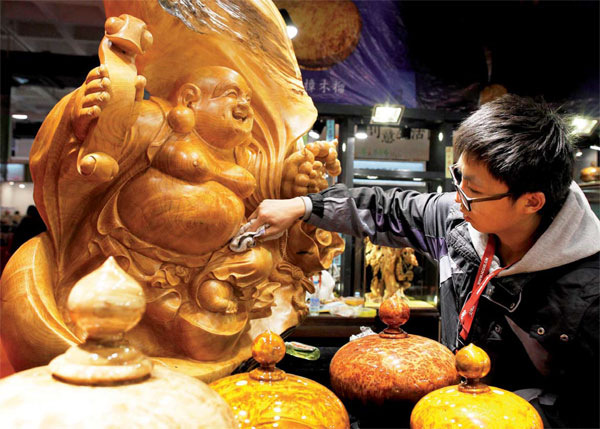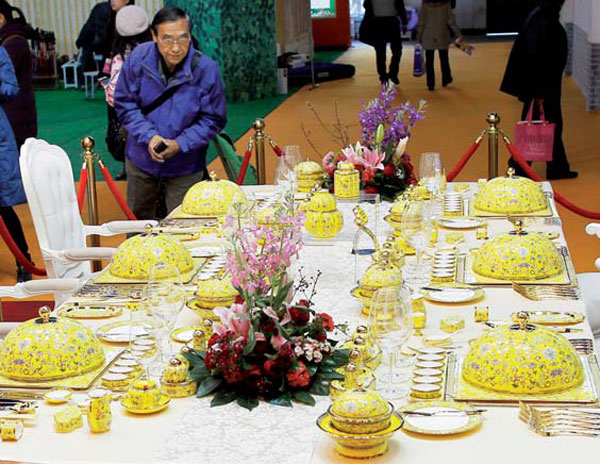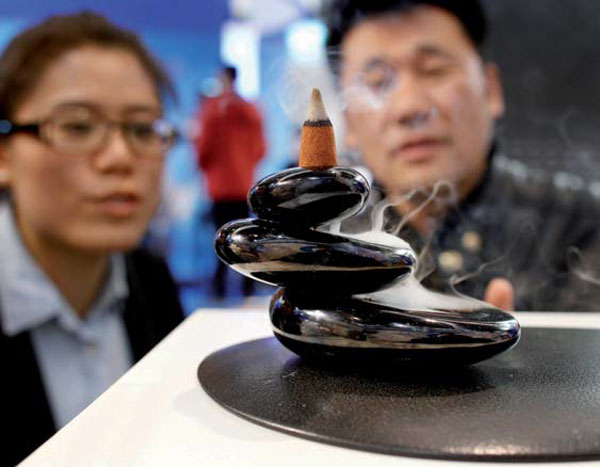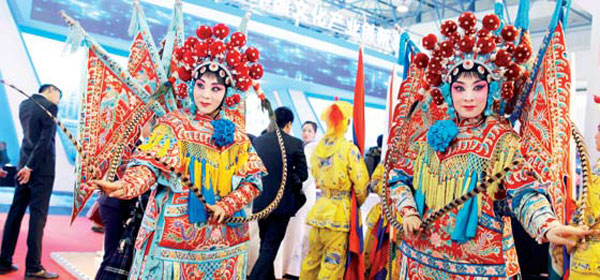Tapping into old and new
Updated: 2014-12-19 09:11
By Liu Xiangrui(China Daily Europe)
|
|||||||||||
Chinese companies designing modern products based on nation's rich cultural heritage
Cultural and creative products that draw inspiration from traditional Chinese culture and the latest technology were highlighted at the 9th Beijing International Culture & Creative Industry Expo.
The annual event attracted a large number of companies from various industries that were eager to promote their designs and products.
|
A staff member polishes a carved wooden sculpture at the 9th China Beijing International Cultural and Creative Industry Expo, held from Dec 10-14. Contracts totaling 105.5 billion yuan ($17.2 billion) were agreed on during the event. Zhu Xingxin / China Daily |
|
Tableware designed for the welcoming banquet in the Water Cube, also known as the National Aquatics Center, during the recent APEC meeting is displayed at the expo. Zhu Xingxin / China Daily |
|
The Mountain Stream, an incense stand designed by LKK, attracts interest. The company's items are often chosen as gifts for foreigners. Zhu Xingxin / China Daily |
LKK, a Chinese creative design company headquartered in Beijing, drew crowds with products such as its incense stand called The Mountain Stream.
The stand is one of the company's flagship products and is often selected as a characteristic Chinese gift for foreigners.
Its design allows the incense smoke to "flow downward" like water along tiers of elegantly shaped metal grooves. The stand's creators drew inspiration from traditional Chinese ink painting to help reflect Chinese aesthetics.
Founded in 2004, LKK has sought to enhance its designs through culture in recent years, according to its vice-president, Chen Bing. The vision of its design brand SANSA is to shape the modern Chinese lifestyle with products that integrate Eastern culture and modern Western design ideas.
Traditional culture has been an important source of inspiration for the company's designs and it has been providing related services for organizations including the Palace Museum, Chen says.
After studying the museum's collection, the company has completed 200 creative design products in 17 thematic series featuring the museum's culture and collection.
For example, some collection items, including ceramic tableware and teaware, were based on the baby images picked from the museum's traditional painting One Hundred Auspicious Children.
They have also developed "The Emperor's Toys", a series of traditional toys based on studies of the childhood of the Chinese emperors. Cloth tigers, jigsaw puzzles, gyroscopes shaped like court official's hats and bamboo dragonflies imitating the dress of an official are part of the series.
"These are gifts of the Palace Museum for modern day children," Chen says. "They not only bring back memories of traditional culture, but also retain practical uses and modern looks."
The company has also joined with the National Museum of China and the Museum of Terracotta Warriors and Horses at Emperor Qinshihuang's Mausoleum Site to help them develop relevant cultural and creative products.
"We try to extract the cultural value of the treasures of our ancestors with modern technology and creative ideas," Chen says.
Other companies like the Beijing Huajiang Culture Development Co Ltd, also known as Honav, are similarly striving to brand their Chinese products through quality designs featuring traditional Chinese culture.
Honav tailor-made 71 design products, altogether about 150,000 pieces of tableware, for the welcoming banquet at the Water Cube venue during the recent Asia-Pacific Economic Cooperation meeting in Beijing.
"The tableware at the banquet was one of the highlights during the APEC meeting. The high-quality pieces with beautiful Chinese elements demonstrated China's rich traditional culture and impressed many foreign leaders and guests at the meeting," says Yu Debin, vice-director of Beijing's bureau of tourism, which was one of the event's organizers.
Honav spent eight months designing and making the tableware. Its products, especially the ceramic items, introduced elements from the imperial tableware of ancient China.
At the expo, Honav signed an agreement with Beijing State-owned Assets Management Co Ltd, which asked Honav to develop the tableware, to launch the series of products on the market.
Honav Vice-President Wu Hui says Chinese enterprises need to improve and add value to their products through quality designs to establish global brands.
"While designing, we must rely on our rich and unique cultural resources and make creative transformations by considering the living habits and consumption needs of modern day people," Wu says.
During the expo, the growing trend in integrating traditional culture with new technologies was further highlighted.
For example, Beijing Peony Electronics introduced its digital and interactive mirror screens that showcased traditional art with modern technology.
The digital screen can serve as a traditional decorative screen displaying well-known paintings or works of calligraphy and the changing images are controlled by its software. The screen can also serve as an intelligent control terminal, like a TV screen.
The interactive mirror uses a short-distance sensor to detect the presence of a person and quickly turns into a mirror. It switches back into a screen that can play videos or display pictures when the person steps away.
"Nowadays, the integration of cultural creativity and design services with other industries has become a major trend," Chen Bing from LKK says.
"The convergence of technologies and culture allows people to come up with excellent design products."
liuxiangrui@chinadaily.com.cn
|
Two Peking Opera actresses perform at the expo. Zhu Xingxin / China Daily |
( China Daily European Weekly 12/19/2014 page24)
Today's Top News
China set to make tracks for Europe
Global net tightened in hunt for Chinese fugitives
Russians flock to stores to pre-empt price rises
Wong Kar-wai: Timeless director who makes time wait
China pledges $3b investment for Europe
Obama to sign Russia sanctions bill, White House says
Beijing condemns Pakistan school attack
Wolfsburg signs China midfielder for 2 1/2 years
Hot Topics
Lunar probe , China growth forecasts, Emission rules get tougher, China seen through 'colored lens', International board,
Editor's Picks

|

|

|

|

|
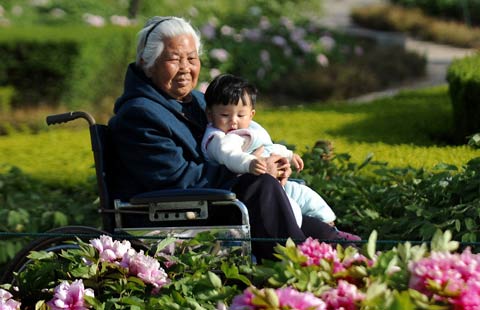
|
